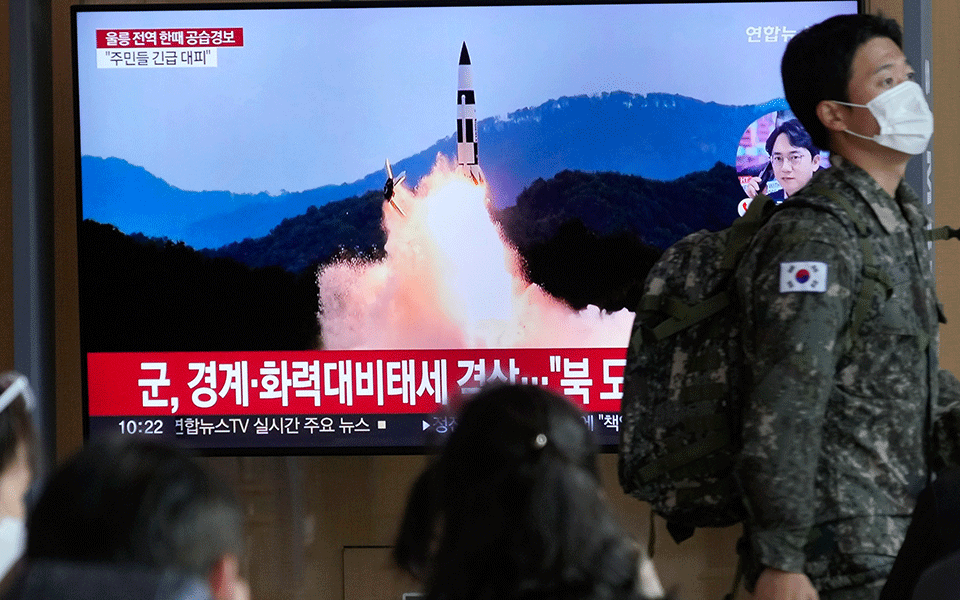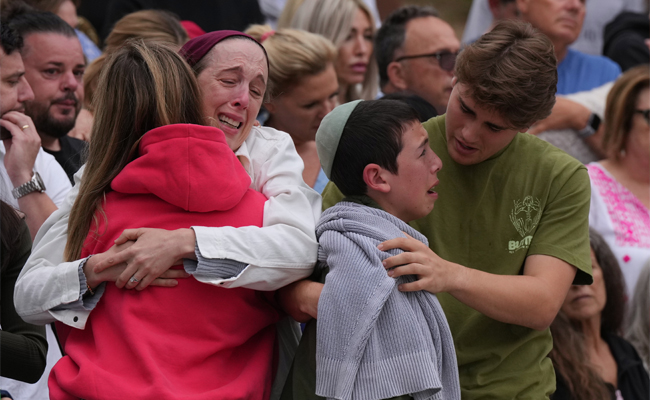Washington (AP): The US and South Korea jointly warned North Korea on on Thursday that use of any kind of nuclear weapon against Seoul or other regional allies would result in the end of Kim Jong Un's regime, as Pyongyang continued to rattle the peninsula with escalating missile tests.
North Korea has launched more than two dozen missiles over the last two days in response to US-South Korean military exercises that began on Monday.
The launches have sent South Koreans scrambling for shelter and further frayed the nerves of a population already mourning the loss of more than 150 people at a horrific Halloween crowd crush.
Defence Secretary Lloyd Austin and South Korean Defence Minister Lee Jong-sup, after meeting on Thursday at the Pentagon, released a joint statement saying they strongly condemned North Korea's escalating military flexing, including ballistic missile test launches, multiple rocket launches and coastal artillery.
Any use of nuclear weapons, including lower-yield tactical nuclear devices against Seoul or other regional allies such as Japan, would result in the end of Kim Jong Un regime by the overwhelming and decisive response of the alliance, Lee said at a joint news conference with Austin.
The US and South Korea will work on response options towards all possible nuclear use scenarios by North Korea, Lee said.
Austin said North Korea's increased aggression would not result in more US troops or assets, such as an additional aircraft carrier, being permanently relocated to the region but that Kim would see a greater US military presence rotating there.
In September the aircraft carrier USS Ronald Reagan visited Korea for the first time in five years, Austin said.
Kim will "see assets move in and out, Austin said.
In its launches on Thursday, North Korea fired an intercontinental ballistic missile, drawing swift condemnation from the White House, which accused Pyongyang of destabilizing the security situation in the region.
The US and South Korea announced that the Vigilant Storm military exercise, which was scheduled to run through Friday, would be extended indefinitely.
Tensions between the US and North Korea have also increased over newly declassified reports that it is providing artillery for Russia to use against Ukraine.
North Korea was shipping an undisclosed number of artillery shells to Russia but trying to make it appear as though they're being sent to countries in the Middle East or North Africa, said National Security Council spokesman John Kirby.
North Korea has reacted to past US-South Korean military drills with missile tests, which was one reason former President Donald Trump called for the exercises to cease for more than a year as he unsuccessfully negotiated with the North Korean leader to end his pursuit of nuclear weapons.
Large-scale US-South Korean military exercises resumed this year. This fall's Vigilant Storm which involves more than 1,600 US and South Korean flights involving about 240 warplanes is the largest such exercise to date, according to the Pentagon.
Pak Jong Chon, a secretary of the North's Workers' Party who is considered a confidant of Kim Jong Un, has called the US-South Korean air force drills aggressive and provocative.
If the US and South Korea attempt to use armed forces against (North Korea) without any fear, the special means of the (North's) armed forces will carry out their strategic mission without delay, Pak said, in an apparent reference to his country's nuclear weapons.
North Korea in recent months has been testing a string of nuclear-capable missiles and it adopted a law authorizing the preemptive use of its nuclear weapons in a broad range of situations. Some experts still doubt North Korea would use nuclear weapons first in the face of US and South Korean forces.
The ballistic missile tests on Wednesday included at least 23 missiles as well as about 100 artillery shells that were fired into an eastern maritime buffer zone. South Korea's military said the 23 weapons were all short-range ballistic missiles or suspected surface-to-air missiles.
One of the ballistic missiles was flying toward South Korea's Ulleung island before it eventually landed 167 kilometers (104 miles) northwest of the island.
South Korea's military issued an air raid alert on the island, according to the South's Joint Chiefs of Staff. South Korean media published photos of island residents moving to underground shelters.
Japanese Defense Minister Yasukazu Hamada said at least two ballistic missiles fired by North Korea showed a possibly irregular trajectory. This suggests the missiles were the North's highly maneuverable, nuclear-capable KN-23 missile, which was modelled on Russia's Iskander missile.
In response to the missile barrage, South Korea quickly launched its own missiles in the same border area.
Let the Truth be known. If you read VB and like VB, please be a VB Supporter and Help us deliver the Truth to one and all.
Abu Dhabi (PTI): Kolkata Knight Riders splurged a record-breaking Rs 25.20 to land top Australian all-rounder Cameron Green even as Indian stars Prithvi Shaw and Sarfaraz Khan went unsold in the Indian Premier League players' auction here on Tuesday.
Green surpassed compatriot Mitchell Starc (Rs 24.75 crore) to become the most expensive overseas player at an IPL auction. This was after Kolkata Knight Riders and Chennai Super Kings were involved in an intense bidding war for him before the latter emerged winner.
KKR also went after Venkatesh Iyer before pulling out of the race against Royal Challengers Bengaluru, who fetched the services of the India all-rounder for Rs 7 crore.
As far as Green is concerned, his salary for the season would still be Rs 18 crore (USD 1.9 million) as the rest of the amount will go towards the BCCI's player development programme as per the rules of the auction for foreign players.
Green, who previously turned up for Mumbai Indians and Royal Challengers Bengaluru, has so far played 29 matches in the IPL to aggregate 707 runs and take 16 wickets.
Shaw, however, went unsold despite his fine run of form in the domestic circuit lately, and so was the case with Sarfaraz, who smashed a 22-ball 73 in a Syed Mushtaq Ali Trophy match for Mumbai on Tuesday.
Big-hitting South African batter David Miller was bought by Delhi Capitals for his base price of Rs 2 crore, but New Zealand swashbuckler Devon Conway, whose base price was also Rs 2 crore, went unsold in the auction.
Seasoned South African opener Quinton de Kock returned to his old base Mumbai Indians for a base price of Rs 1 crore.
A total of 359 players -- 246 Indians and 113 overseas players -- are part of the mini auction pool with the 10 franchises bidding to fill up a maximum of 77 slots, including 31 reserved for foreign players.





